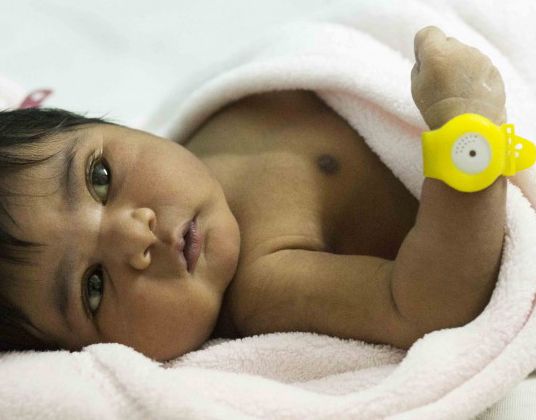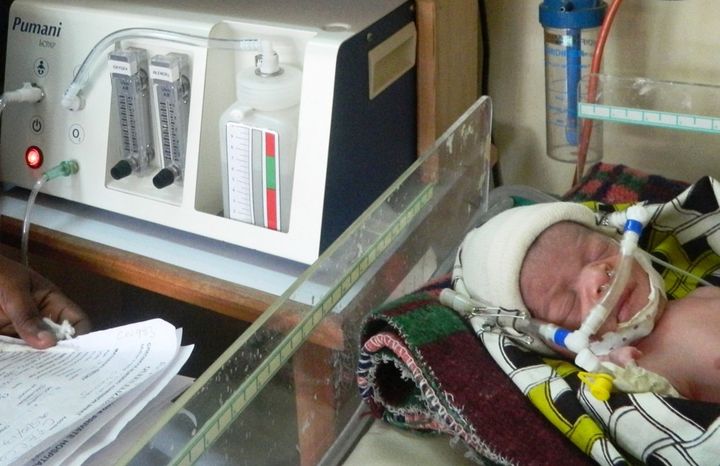
Bempu Wrist Band

Infant in Malawi on Pumani
More than 7,300 newly born children will die today. Less than 120 of those deaths will occur in the United States, Europe, Japan or other developed nations. Some will be in Latin America, the Caribbean, China and the Middle East but overwhelmingly majority of these deaths (more than 80 percent) will take place in Africa and South Asia where in many countries a new born child is 15 times more likely to die in its first 30 days as a child born in the Europe or the United States.
A 2009 report by the Harvard School of Public Health stated, “Just because a good health technology exists does not mean that it will be delivered, used, or achieve its potential to bring good health, especially for poor people in poor countries.” The infant death toll across the developing world clearly documents that conclusion.
One major problem has been appropriate medical equipment. The type of equipment used by the world’s wealthier countries is not only too expensive for health care providers in lower and middle income countries, it is poorly designed for providing quality care in the kind of facilities in which most of the world’s people receive medical care. These clinics and hospitals are not the dust free, climate controlled buildings familiar to the developed world. Many don’t have reliable electricity. Most are well removed from ready access to technicians with the training required keep advanced medical equipment functioning properly. Often these facilities lack the staff to provide the regular monitoring that much advanced medical equipment requires.
But we have made remarkable progress in recent years in addressing that problem. The United States Agency for International Development, the Bill and Melinda Gates Foundation, Grand Challenges Canada and others have invested heavily in support of innovators working to produce products that are not only effective but far less expensive and far better suited for use in the kind of conditions that developing world health care providers serve.
One example is a low cost device developed by engineering students at Rice University. Working with doctors in Malawi they produced a device known as the Pumani.
Perhaps the single largest cause of death for infants in developing countries is respiratory distress caused by either premature birth or infection or both. The indicated treatment in developed countries for such infants is continuous positive airway pressure or CPAP, using a machine that generates constant mild air pressure to keep the airways open. Until recently such devices cost in excess of $6,000, were relatively complex and required a significant amount of skilled monitoring to use. The Pumani uses air pumps originally designed for use in aquariums. It costs about one eighth as much as the models it was designed to replace. It is durable, reliable and more easily monitored. Clinical trials in Malawi indicate that survival rates can be increased from the 25 percent experienced with the treatment previously used to 70 percent with the Pumani—a 180 percent improvement.
The Punami is only one of dozens of innovative new devices that could be real game changers in terms of the survival of developing world infants and mothers. A second is the Bempu bracelet. Bempu is a nonprofit corporation headquartered in India with about 15 professionals specialized in medicine, mechanical engineering, product design and public health. After consulting with health care providers throughout the developing world they concluded that hypothermia was not only a leading contributor to infant deaths but that there was a low cost means of preventing such deaths. The result is a small plastic bracelet worn of the infant’s wrist that monitors body temperature and triggers an audio visual alarm when body temperature begins to fall. As of this summer it has been tested on more than 1000 infants in clinics across India. The bracelet sells for under $30.00.
There is also a greatly elevated risk to the mothers of newborns in the developing world. In the U.S. less than one mother in 10,000 dies as a result of childbirth. In some countries the probability of death in child birth is 100 times greater—1 in 100. The largest cause of this death rate is post-partum hemorrhaging or PPH which some studies indicate accounts for 25 percent of maternal post-partum deaths.
In 2002, Dr. Carol Brees of Louisville and Dr. Paul Hensleigh of Stanford began working with a hospital in Pakistan to reduce death from obstetric hemorrhage. Their solution was a life-saving garment that became known as “LifeWrap.” When a patient is bundled up in this neoprene garment, the compression created slows blood loss and reverses shock by increasing blood pressure to the heart, brain, and lungs. It has proven effective in stabilizing patients for up to 3 days and according to some studies reduced mortality by nearly half. So far it has been used on over 10,000 women in 33 countries.
These are only a few examples of the innovations that have flowed from the investments made by Gates, U.S.A.I.D and Grand Challenges Canada. Clearly those investments have been richly rewarded by the development of new devices that can literally save millions of lives in the developing world. But high rates of mortality persist. Only a tiny percentage of the health providers in the developing world have ever seen or even heard of any of these lifesaving tools. Creating the technology is only the first step and the obstacles to taking the second step (getting these great products in the field where they are needed) is an equally large challenge.
No one knows how many developing world clinics exist but if you assume that there is at least one for every 15,000 patients that is a total of more than 400,000 facilities. And they are scattered across a vast geographic area. In Africa, for instance, it is more than a 6,000 mile trip from the Straits of Gibraltar down the continent to Cape Town (More than twice the distance of travel from New York to Los Angeles) and it is a 5,000 mile trip from Nouakchott, Mauritania on the Africa’s Atlantic Coast to the Horn of Africa on the Indian Ocean. The continent is home to 1.1 billion people living in 54 separate countries. Management of health care resources differs in each of these countries with decision making highly centralized in some and disbursed to local authorities in others. Some of these health care providers receive support from charities, foreign governments or even reimbursements from private insurance policies while others are dependent entirely on funding from their own government.
Added to all of this is yet another level of complexity. Africa generally has a weak and fragmented private sector. This impedes commerce throughout the continent impacting nearly every aspect of economic activity. Medical device distribution is no exception. The size, capital and expertise of African commercial activity continue to be a major barrier to getting needed equipment into the hands of care providers. Even when health care providers know what products will be most helpful in saving patient lives, accessing the market place for such products has too often been an insurmountable challenge.
The difficulties faced by the emerging businesses attempting to enter the medical device distribution business are compounded by the challenges facing all African business. These include obtaining the credit necessary to complete transactions; working in currencies that at times fluctuate dramatically against the dollar, euro and pound; logistics required to transport products to the continent and then forward them to the location of the health care provider; fraudulent vendors and impediments imposed by corrupt or incompetent government officials.
Unfortunately, these problems are not likely to disappear anytime soon and they pose a hurdle to not only the distribution of equipment important to meet the continent’s health care needs but to its broader economic future. There is no silver bullet but with respect to increasing the flow of needed medical devices there is hope. My nephew, a young man named Noah Perin came up with a very interesting idea.
Noah has both an MBA and a MPP (Masters in Public Policy) from Duke and after several years of working for Microsoft he moved to PATH (Program for Appropriate Technology in Health) an NGO largely funded by the Bill and Melinda Gates Foundation. He worked to find better technologies to address a number of developing world health needs. While encouraged by the progress being made in finding such technologies, Noah was deeply frustrated by the lack of progress in getting those technologies into the hands of health care professionals where they could actually be used to save lives.
Eventually Noah began having conversations with his cousin (my son, Brendan Lilly) about various approaches for solving that problem. Together the two cousins began building a web based e-commerce platform to reach medical product distributors around the world but particularly in Africa and South Asia. The goal was to not only provide both distributors and health care providers with far more information about available products but also create a secure means of purchasing those products and a reliable system of delivering them—one that could reach villages virtually across the continent Africa and throughout the Indian Subcontinent. The web based commerce platform would support itself by charging customers a percent based commission on all sales and in most instances, dramatically cut product pricing by not only cutting the price of products but also reducing transportation and currency exchange costs.
In essence, their plan was to build a web based business along the lines of Amazon or Alibaba but specializing in the arcane world of health care products designed to meet the needs of patients in low and middle income countries.
To bring that plan to life they had to accomplish a number of difficult tasks. They needed to raise enough capital to put the plan in motion. They needed to identify and enlist producers of these products and convince them to sell the products through the new web platform. They needed to sign agreements with reliable distributors with established relationships with health care providers across the developing world. They needed to construct a massive web based platform to accommodate all of the information transaction capabilities and security required for such a business. They had set up secure payment arrangements and find reliable and cost effective shipping arrangements.
In April of 2015 the company, VIA Global Health, was founded. They had raised only $12,000 in capital but began building a website, seeking to find equipment producers willing to sign agreements to sell through their platform and at the same time began recruiting African based medical device distributors to sign formal agreements to buy and distribute products through the platform.
One year later they had raised $180,000 in capital including a $55,000 grant from the state of Washington, signed 8 medical equipment producers as well as formal agreements with 7 medical supply distributors operating in 4 countries. The company website was launched with 30 products and during the first full month of operation in May, 2016 and generated requests for prices on more than $55,000 worth of merchandise.
By early 2017, the number of producers listing products on the site has swollen from 6 to 25 and about half a dozen additional agreements were being processed. The number of distributors within the network had expanded from 7 to more than 57 in 16 countries. The number of products listed on the website had surpassed 46,000. VIA currently has more than $4 million in enquiries currently in the sales pipeline
One big question at VIA right now is why is there such large gap between requests for product price information and final sales? One possibility is that purchase orders in Africa can take much longer to put together than in other parts of the world. Most clinics are extensions of government bureaucracies. There is significant red tape involved in simply making a decision as to what to order. Are these requests coming from serious potential buyers and if so what portion will actually be converted into final transactions? Only time will tell.
But the progress to date has been sufficient to gain the attention of a Silicon Valley global venture capital seed fund known as 500 Startups. In January the organization agreed to invest $150,000 of its own capital in VIA and accept the company (which now includes Africa public/private partnership veteran Brian Krawczyk) into their highly selective San Francisco based seed capital mentoring program. VIA was one of 44 companies selected from a field of more than two thousand. They continue to run their business from 500 Startup’s offices in San Francisco but in daily contact with other young startup managers and with daily personal mentoring from a wide array of experts on issues like customer acquisition, web design and user experience, business metrics and lean startup practices. Perhaps most importantly, 500 Startups is at the center of a large network of venture capitalists and potential investors who will gain familiarity with the company and hopefully provide the funds necessary to grow the business.
Like any startup, the company faces numerous hurdles—only a portion of which can now be anticipated. But it is hard to imagine that any small group of people could have accomplished more in such a short period of time and with such limited resources than team VIA. They are making real progress toward proving that it is still possible to do well by doing good!
